LTE evolution for IoT
connectivity
Nokia white paper
LTE evolution for IoT connectivity white paper
�
Contents
1. Executive summary
2.
3.
IoT market landscape
LPWA IoT requirements
4. LPWA IoT technology landscape
5.
LTE evolution for cellular IoT
6. Conclusion
3
4
6
7
9
17
Page 2
www.nokia.com
�
1. Executive summary
The Internet of Things (IoT) is the next revolution in the mobile ecosystem. IoT services are likely to be a
key driver for further growth in cellular. An estimated 30 billion connected devices will be deployed by 2025
[Machina Research, May 2015], of which cellular IoT (i.e. 2G, 3G and 4G technologies used for IoT but not
specifically optimized for IoT) and Low-Power Wide-Area (LPWA) modules are forecast to account for
7 billion units in 2025 [Machina Research, May 2015].
Cellular IoT is expected to provide numerous services, including utility meters, vending machines,
automotive (fleet management, smart traffic, real time traffic information to the vehicle, security
monitoring and reporting), medical metering and alerting. Already, devices such as e-book readers, GPS
navigation aids and digital cameras are connected to the internet.
The key requirements for cellular IoT to enable these services and be competitive are:
• Long battery life
• Low device cost
• Low deployment cost
• Extended coverage
• Support for a massive number of devices.
This white paper outlines a cellular IoT solution based on LTE that meets these requirements and
enhances the radio and core networks. The radio network needs to work with simple, low cost devices.
The transmission and higher layer protocols need to help devices consume less power, with the aim of
achieving a battery life of over ten years. Finally, extended coverage is required for deep indoor and rural
areas.
Network elements need to handle charging, subscription and massive support for small packages. Today,
LTE supports IoT with so-called Cat.1 devices, while LTE-Advanced extends device battery life to ten years
with a power saving mode. LTE-Advanced Pro further optimizes coverage, device battery life and costs, as
well as capacity for a massive number of connected devices with the introduction of two new technologies:
eMTC (enhanced Machine Type Communication, often referred to as LTE-M) and NB-IoT (NarrowBand-
Internet of Things).
These two systems will support a scalable solution for data rates. Both solutions can be deployed either in
shared spectrum together with legacy LTE, or as stand-alone, in a refarmed GSM carrier with a bandwidth
as narrow as 180kHz for NB-IoT. Nokia believes that LTE-M, NB-IoT, and EC-GSM-IoT (Extended Coverage
GSM for IoT) are better able to satisfy the connectivity profiles and requirements for IoT than legacy
cellular networks. This is because by upgrading existing networks with an easy software upgrade, they
provide optimized device KPIs, battery life, coverage and cost, along with the expected benefits from the
use of licensed spectrum, such as no coexistence issue with other cellular networks.
Page 3
www.nokia.com
�
2. IoT market landscape
The IoT interconnects “things” and autonomously exchanges data between them. “Things” may be
machines, parts of machines, smart meters, sensors or even everyday objects such as retail goods or
wearables. This capability will bring about tremendous improvements in user experience and system
efficiency. Support for IoT requires Machine-to-Machine (M2M) communication. M2M is defined as data
communication among devices without the need for human interaction. This may be data communication
between devices and a server, or device-to-device, either directly or over a network. Examples of M2M
services include security, tracking, payment, smart grid and remote maintenance/monitoring. The total
M2M market is estimated to be 30 billion connected devices by 2025 [Machina Research, May 2015].
Fixed and short-range communication will be used for most connections. However, there is also a
significant number (around seven billion by 2025) of connections expected via traditional cellular IoT and
LPWA networks (Figure 1).
35
30
25
20
15
10
5
-
2015
-
2016
2017
2018
2019
2020
2021
2022
Fixed & short range
LPWA
Traditional cellular
2023
2024
2025
Figure 1: Billion global connections, 2015-2025 (Machina Research, May 2015)
© Nokia 2016
LPWA is split into two separate sub-categories. On the one hand, there are the current proprietary LPWA
1
technologies, such as SigFox and LoRa, which typically operate on unlicensed spectrum. On the other hand,
there are the forthcoming 3GPP standardized cellular IoT technologies, in short cellular IoT, which typically
operate on licensed spectrum.
Designing cellular IoT to meet the key requirements laid out in Figure 2 will enable it to address the
combined market of traditional cellular IoT and LPWA IoT connections shown in Figure 1. To reach the
total potential volume of seven billion units by 2025, the cellular IoT market will need to grow 35 percent
annually on average.
IoT applications and services vary widely in terms of their service requirements, data throughput, latency
and connectivity reliability.
Page 4
www.nokia.com
�
• Traffic information
• eCall
• Smart grids
Energy/Smart grid
Vehicle telematics
Irrigation control
•
• Environment sensing
• Animal tracking
Agriculture
• Electric
• Water
• Gas
• Heat
•
Infrastructure & production
Smart metering
Infrastructure monitoring
• Traffic sensors & control
• Street lighting
•
• Trash and waste containers
• Public events – location services
• Advertising displays
• ATM’s, vending machines
• Smart parking
Smart city
• Smoke detectors
• Security systems
• Smart appliances
• Smart heat
• Control/monitoring
• Video surveillance
Secure/Smart home
• Motorcycles, bicycles
• Cars
• Truck trailers
• Shipping containers
• Kids, pets
•
• Find my stuff
Insurance – valuable assets
• Earthquake sensors
• Avalanche and flooding
• Heating and AC
• Equipment status
• Forest fires
• Air pollution
Tracking
Environment & Industrial
• Medical wearable’s
mHealth
Figure 2: Cellular IoT use cases
The main vertical sectors for cellular IoT connections will have the following market shares [Machina
Research, May 2015]:
100%
75%
50%
25%
0%
2015
Connected car
Connected industry
Connected cities
Connected living and working
2025
Connected health
Figure 3: Vertical sectors for IoT market share, 2015/2025 (Machina Research, May 2015)
3
© Nokia 2016
Page 5
www.nokia.com
�
3. LPWA IoT requirements
The key requirements for LPWA networks to successfully support massive IoT deployment are:
• Long battery life
• Low device cost
• Low deployment cost
• Extended coverage
• Support for a massive number of devices.
3.1 Long battery life
Mobile phone and especially smartphone users are accustomed to charging their device batteries
frequently. However, many IoT devices must operate for very long times, often years, without human
intervention. A good example is a fire alarm device sending data directly to a fire department. The interval
between battery changes in such a device is a very important cost factor.
Long battery life would also enable completely new connected device applications not yet deployed. Many
objects around us are not connected to an external power supply, but are battery operated or even work
without a battery. These devices can also be brought into the network.
The industry aims to achieve a minimum of 10 years of battery operation for simple daily connectivity with
a small amount of data exchanged.
3.2 Low device cost
IoT connectivity will mostly serve very low ARPU users, giving a ten-fold reduction in revenue compared to
mobile broadband subscriptions. The current industry target is for a module cost of less than 5 USD. To
enable a positive business case for cellular IoT, the total cost of ownership (TCO) including the device must
be extremely low.
3.3 Low deployment cost
The network cost of IoT connectivity, including initial CAPEX and annual OPEX, must also be kept to a
minimum. A simple, centrally pushed software upgrade can deploy LPWA IoT connectivity on top of existing
cellular networks to avoid any new hardware and site visits and keep CAPEX and OPEX to a minimum.
Marketing and sales have a better understanding on new services that are being launched and how these
perform.
Page 6
www.nokia.com
�
3.4 Extended coverage
Extended coverage is important in many IoT applications. Simple examples are smart meters, which are
often in the basements of buildings behind concrete walls. Industrial applications such as elevators or
conveyor belts can also be located deep indoors. This has driven the M2M community to look for methods
to increase coverage by tolerating lower signal strength than is required for other devices. The target
for the IoT connectivity link budget is an enhancement of 15-20dB. This coverage enhancement would
typically be equivalent to the signal penetrating a wall or floor, enabling deeper indoor coverage.
3.5 Support for a massive number of devices
IoT connectivity is growing significantly faster than normal mobile broadband connections and by 2025
there will be seven billion connected devices over cellular IoT networks. This is equivalent to the current
number of global cellular subscriptions. The density of connected devices may not be uniform, leading to
some cells having very high numbers of connected devices. This means that LPWA IoT connectivity needs
to handle many simultaneous connected devices.
4. LPWA IoT technology landscape
Today, 2G modules are the dominant solution for IoT, but the fastest growth will be in LTE modules. Low
power, wide area and low cost modules are key enablers for the rapid changes expected. A module cost
below 5 USD is needed for LPWA IoT devices to gain market share from short-range connectivity standards
and wireless sensor networks like ZigBee, BT LE and Wi-Fi. The key LPWA IoT solutions are shown in
Figure 4.
LoRa
N/A
GSM (Rel.8)
N/A
EC-GSM-
IoT (Rel.13)
N/A
LTE (Rel.8)
eMTC (Rel.13)
NB-IoT (Rel.13)
Cat.1
Cat.M1
Cat.NB1
LTE user equipment
category
Range
Max. coupling loss
Spectrum
<15km
155dB
Unlicensed
<1GHz
<35km
144dB
Licensed
GSM bands
<35km
164dB
Licensed
GSM bands
<100km
144dB
Licensed LTE
bands In-band
<100km
156dB
Licensed LTE
bands in-band
Bandwidth
<500kHz
200kHz
200kHz
Max. data rate*
<50kbps
(DL/UL)
<500kbps
(DL/UL)
<140kbps
(DL/UL)
*Max data rates provided are instantaneous peak rates.
Figure 4: LPWA IoT and legacy LTE connectivity overview
LTE carrier
bandwidth (1.4
– 20MHz)
<10Mbps(DL)
<5Mbps(UL)
1.08MHz
(1.4MHz carrier
bandwidth)
<1Mbps
(DL/UL)
<35km
164dB
Licensed LTE in-
band guard-band
stand-alone
180kHz
(200kHz carrier
bandwidth)
< 170kbps (DL)
< 250kbps (UL)
Page 7
www.nokia.com
�
LPWA IoT solutions can be divided into proprietary (i.e. non-3GPP) LPWA technologies and (3GPP) cellular
IoT; SigFox and LoRa are both proprietary technologies deployed in unlicensed bands. For all these
technologies, deployment in spectrum lower than 1GHz spectrum helps achieve maximum coverage, but
higher bands in the spectrum may still be used.
Three separate tracks for licensed cellular IoT technologies are being standardized in 3GPP:
• LTE-M, an evolution of LTE optimized for IoT in 3GPP RAN. First released in Rel.12 in Q4 2014, further
optimization is being included in Rel.13 with specifications completed in Q1 2016.
• NB-IoT, the narrowband evolution of LTE for IoT in 3GPP RAN, included in Rel.13 with specifications
completed in Q2 2016.
• EC-GSM-IoT, an evolution of GSM optimized for IoT in 3GPP GERAN, included in Rel.13 with
specifications completed in Q2 2016.
Finally, a 5G solution for cellular IoT is expected to be part of the new 5G framework by 2020. The link
budget is similar in all solutions, with a slight improvement for narrowband solutions such as NB-IoT and
EC-GSM-IoT. LoRa and SigFox are planned to share spectrum with other solutions in the unlicensed bands.
Some alternative proposals for NB-IoT operate in a dedicated 200kHz carrier refarmed from GSM, but do
not support spectrum sharing with LTE networks. This is why Nokia has supported the NB-IoT proposal
from the 3GPP Study Item phase. Based on an LTE narrowband evolution, this is designed to operate in
a 200kHz carrier refarmed from GSM but has the further advantage of being able to operate in shared
spectrum with an existing LTE network, thus requiring no additional deployment of antennas, radio or other
hardware. The solutions for LTE-M, NB-IoT and EC-GSM-IoT will equally operate in spectrum shared with
existing LTE or GSM networks - LTE-M and NB-IoT would be supplementary solutions addressing different
use cases, with higher capacity on LTE-M and slightly lower cost and better coverage on NB-IoT.
The deployment options for the cellular IoT solutions are different and depend on the mobile operator’s
installed base. To benefit from good propagation and penetration characteristics, all solutions should
ideally be deployed in sub 1GHz bands. Some operators may have GSM deployed in the 900MHz band
without enough LTE spectrum to deploy LTE-M or NB-IoT within the LTE band. In such cases, EC-GSM-IoT
could enable sharing of the carrier capacity in the GSM band. Alternatively, a refarmed GSM carrier would
enable deployment of NB-IoT operating in 180kHz bandwidth.
More precisely, deployment options for NB-IoT are shown in figure 5.
T
o
I
-
B
N
T
o
I
-
B
N
T
o
I
-
B
N
LTE carrier
In-band
GSM carrier
Standalone
LTE carrier
Guard-band
Figure 5: NB-IoT deployment options
4
© Nokia 2016
Page 8
www.nokia.com
�
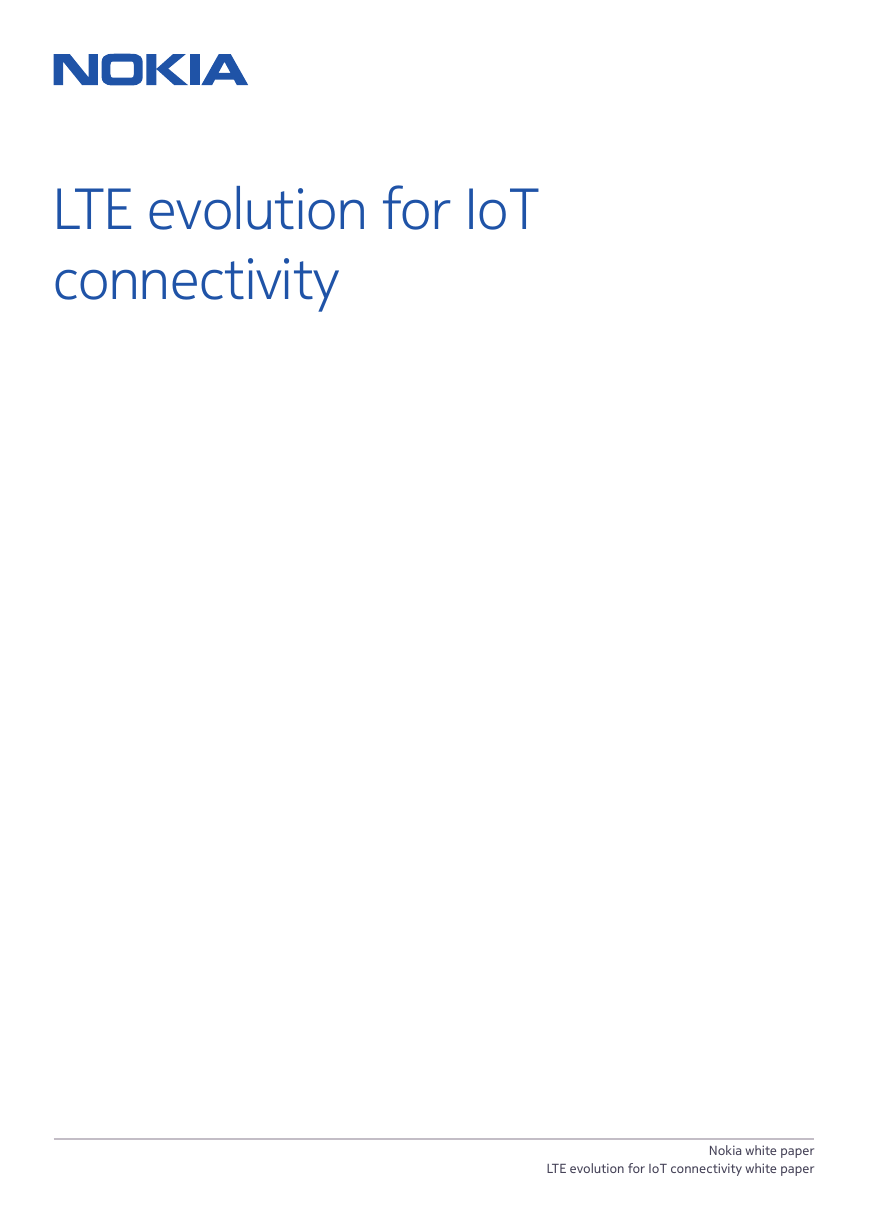
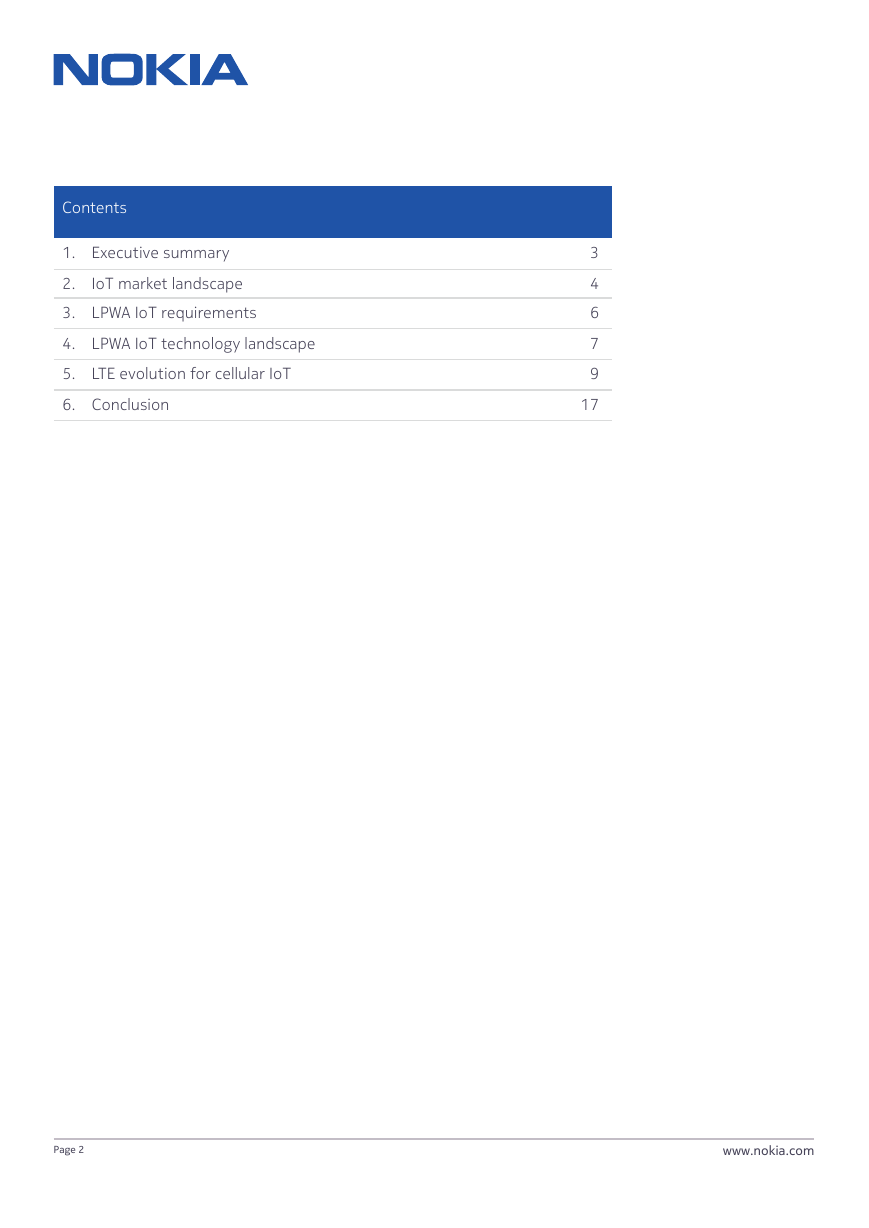
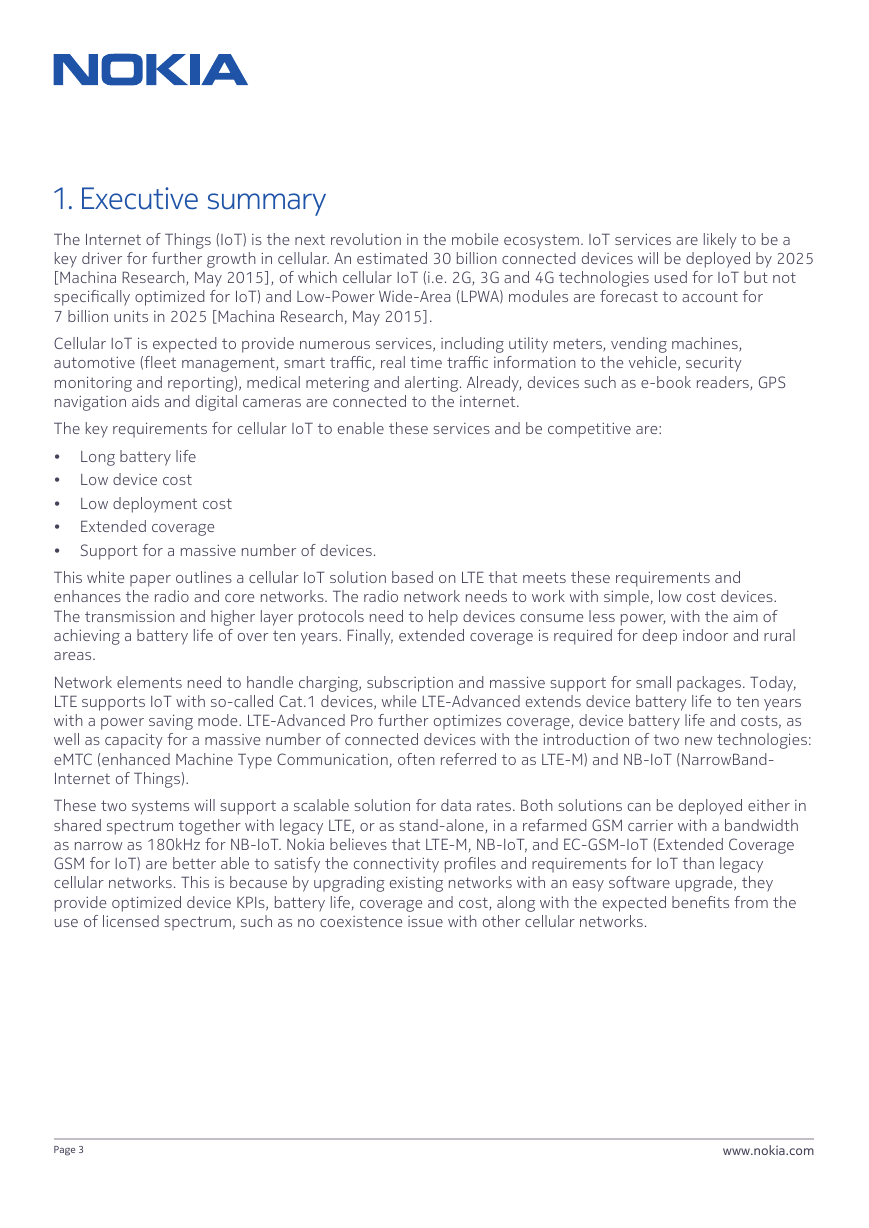
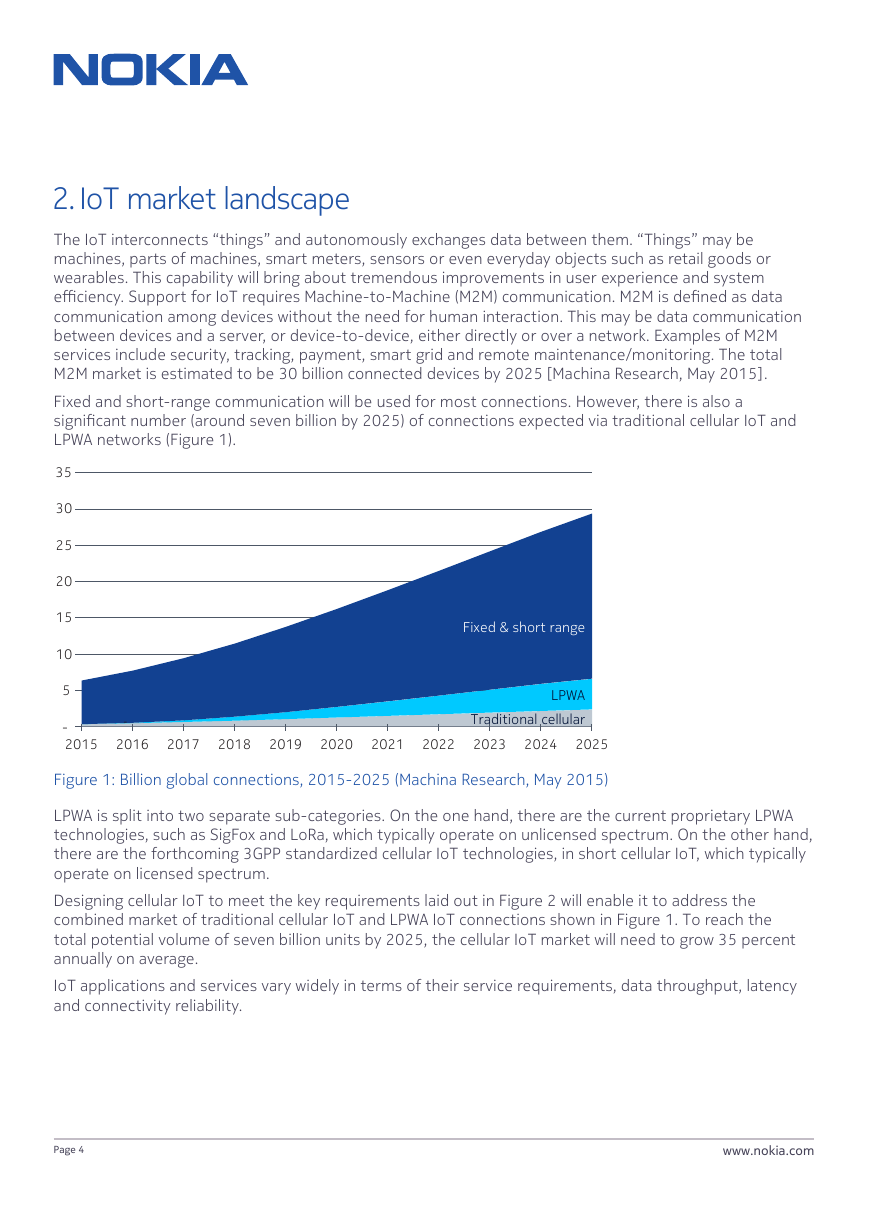
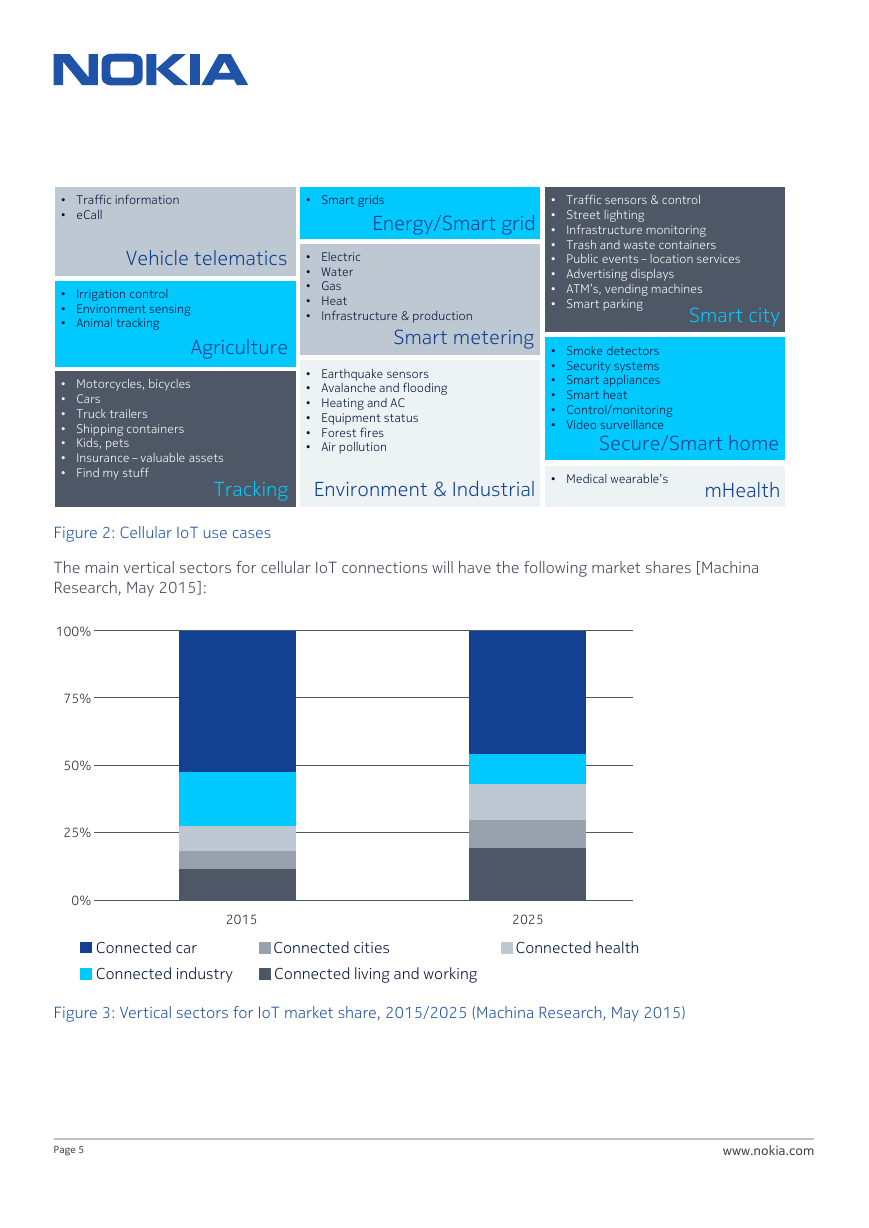
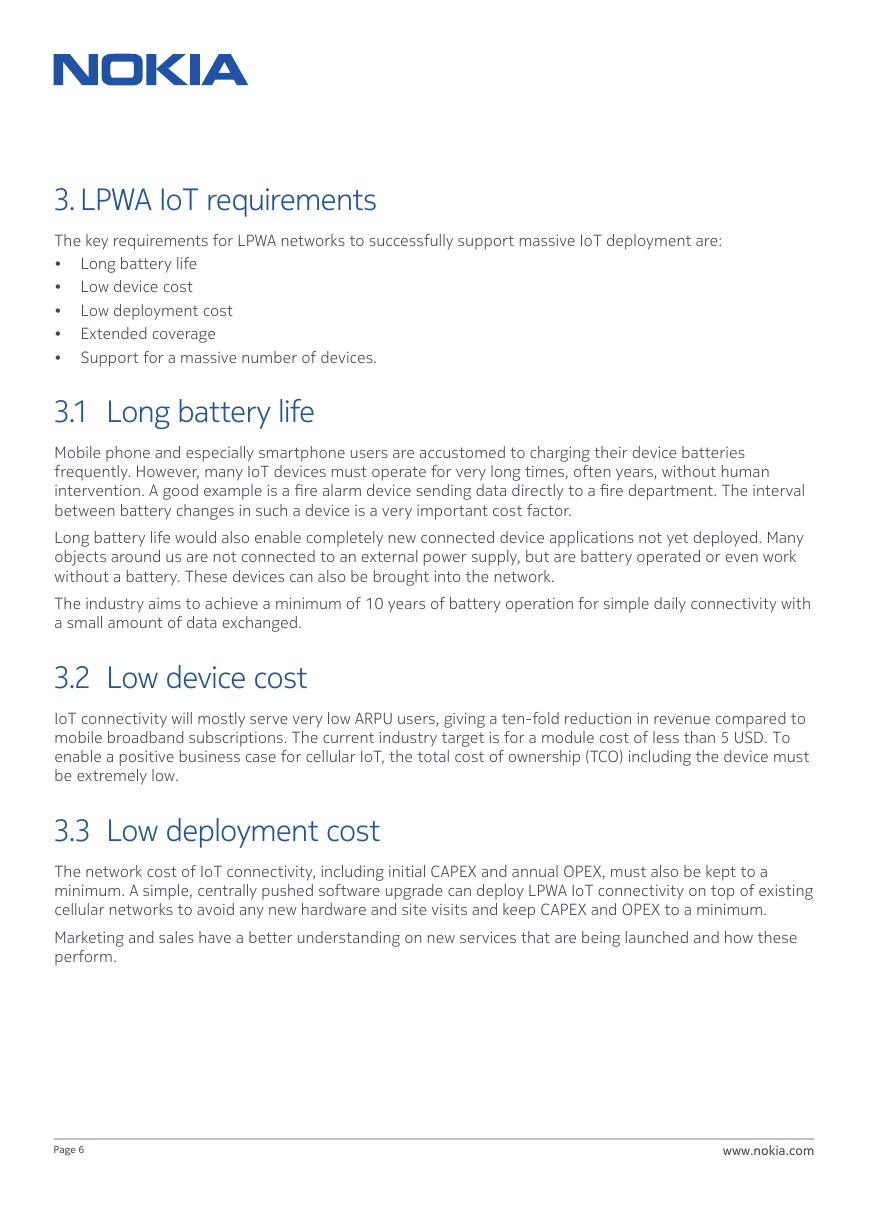
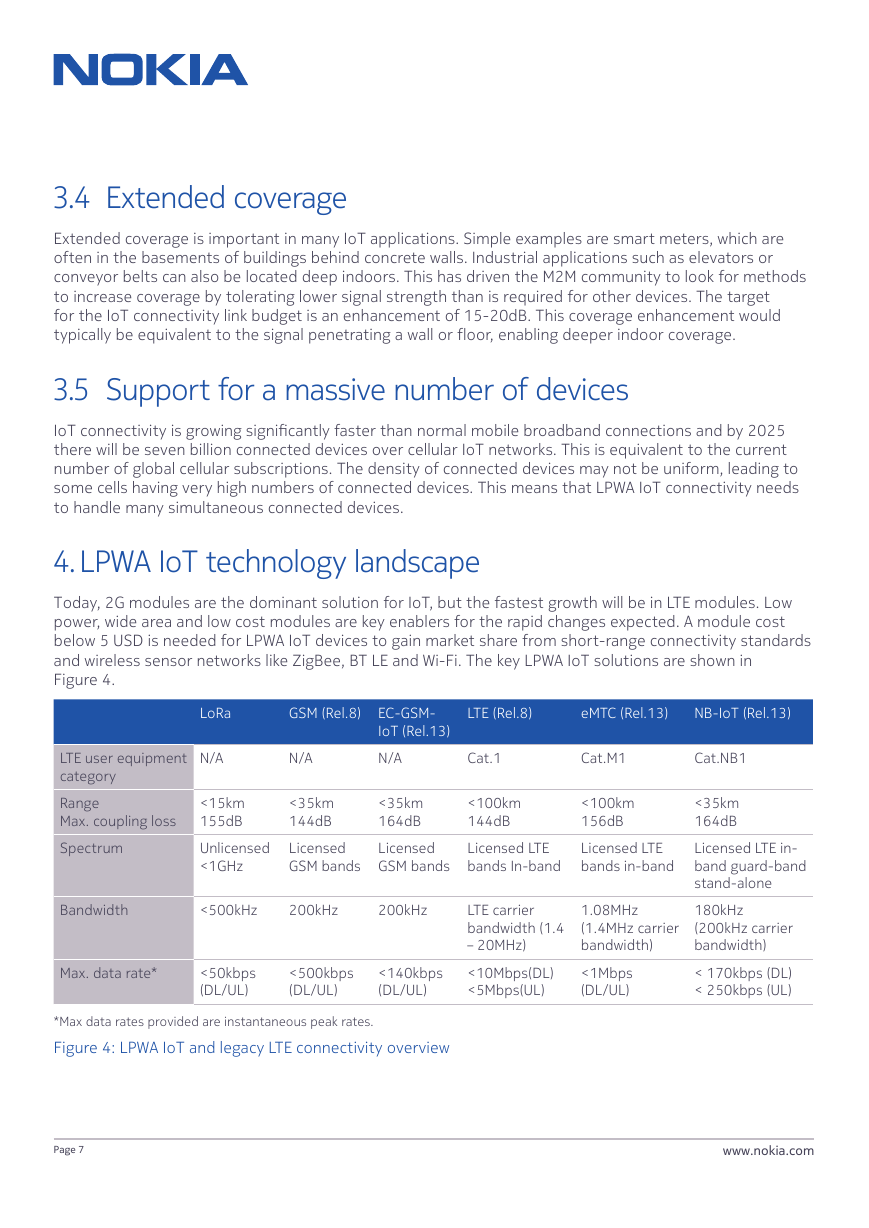
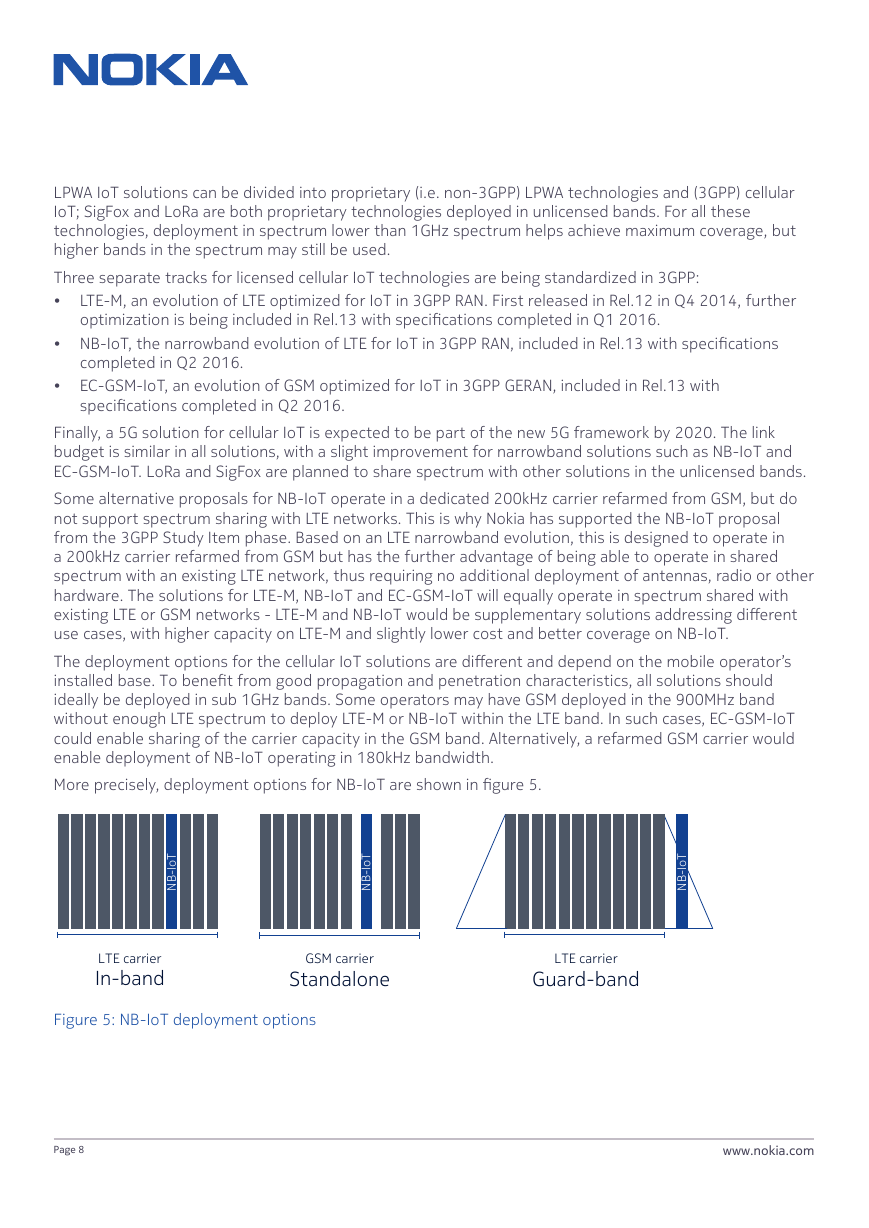








 2023年江西萍乡中考道德与法治真题及答案.doc
2023年江西萍乡中考道德与法治真题及答案.doc 2012年重庆南川中考生物真题及答案.doc
2012年重庆南川中考生物真题及答案.doc 2013年江西师范大学地理学综合及文艺理论基础考研真题.doc
2013年江西师范大学地理学综合及文艺理论基础考研真题.doc 2020年四川甘孜小升初语文真题及答案I卷.doc
2020年四川甘孜小升初语文真题及答案I卷.doc 2020年注册岩土工程师专业基础考试真题及答案.doc
2020年注册岩土工程师专业基础考试真题及答案.doc 2023-2024学年福建省厦门市九年级上学期数学月考试题及答案.doc
2023-2024学年福建省厦门市九年级上学期数学月考试题及答案.doc 2021-2022学年辽宁省沈阳市大东区九年级上学期语文期末试题及答案.doc
2021-2022学年辽宁省沈阳市大东区九年级上学期语文期末试题及答案.doc 2022-2023学年北京东城区初三第一学期物理期末试卷及答案.doc
2022-2023学年北京东城区初三第一学期物理期末试卷及答案.doc 2018上半年江西教师资格初中地理学科知识与教学能力真题及答案.doc
2018上半年江西教师资格初中地理学科知识与教学能力真题及答案.doc 2012年河北国家公务员申论考试真题及答案-省级.doc
2012年河北国家公务员申论考试真题及答案-省级.doc 2020-2021学年江苏省扬州市江都区邵樊片九年级上学期数学第一次质量检测试题及答案.doc
2020-2021学年江苏省扬州市江都区邵樊片九年级上学期数学第一次质量检测试题及答案.doc 2022下半年黑龙江教师资格证中学综合素质真题及答案.doc
2022下半年黑龙江教师资格证中学综合素质真题及答案.doc